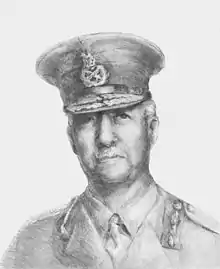Lionel Bond
Lieutenant-General Sir Lionel Vivian Bond, KBE, CB (16 June 1884 – 4 October 1961) was a senior officer in the British Army.[1]
Sir Lionel Bond | |
|---|---|
 | |
| Birth name | Lionel Vivian Bond |
| Born | 16 June 1884 Aldershot, Hampshire, England |
| Died | 4 October 1961 (aged 77) Surrey, England |
| Allegiance | |
| Service/ | British Army |
| Years of service | 1903–1941 |
| Rank | Lieutenant-General |
| Unit | Royal Engineers |
| Commands held | Commanding Officer, Chatham Area Commandant, Royal School of Military Engineering Inspector of Royal Engineers, War Office Malaya Command |
| Battles/wars | Zakka Khel and Mohmand, India (1908) Mesopotamia, World War I World War II |
| Awards | KBE, CB |
Military career
Born the son of Major-General Sir Francis George Bond (1856–1930), and brother of Major-General Richard Lawrence Bond (1890–1979), Bond was commissioned as a second lieutenant into the Royal Engineers in 1903. He first saw action in military operations in Zakka Khel and Mohmand expeditions, India in 1908. He also fought in Mesopotamia during World War I.
After graduating from the first postwar course at the Staff College, Camberley in 1919, in 1922, Bond published a literary attack on Captain Liddell Hart's new theories on tank warfare, stigmatising them as "flapdoodle of the most misleading kind".[2]
Bond was appointed Chief Engineer at Aldershot Command in 1934, General Officer Commanding Chatham Area in 1935 and Commandant of School of Military Engineering and Inspector of the Royal Engineers in 1938.
Defence of Singapore

During World War II, Bond took over Sir William Dobbie as General Officer Commanding Malaya on July 1939. Bond was aware that his predecessor had made an assessment on the war situation in Malaya, and was convinced with his findings that the Japanese would attempt to seize Singapore by attacking Malaya from the north through Siam. With only a small number of British force in his command, he knew he could not undertake the defence of the entire Malayan Peninsula. Thus in early 1939, Bond decided on the strategy of close defence of Southern Johore, and the Singapore island.[3]
He completed his term of office in Malaya on 29 April 1941. He retired from active military service soon after, and died in 1961.
Quotes
"The United States Fleet is the most powerful factor deterring the activity of an enemy of Britain in the Pacific area."[4]
References
- "Obituary: Lieut.-Gen. Sir Lionel Bond". The Times. The Times Digital Archive. 6 October 1961. p. 17.
- Lee, Cecil (1994) Sunset of the Raj: fall of Singapore, 1942. Edinburgh: Pentland Press and 'The tactical theories of Captain Liddell Hart (a criticism)' by Brevet Lieutenant-Colonel L V Bond, in The Royal Engineers Journal, written in reply to article by Liddell Hart, entitled 'A study of the new French infantry regulations' in The Royal Engineers Journal, 1922 May – with papers relating to Liddell Hart's rely to criticisms, including proof copy of reply, published as 'Colonel Bond's criticisms (a reply) by Liddell Hart in The Royal Engineers Journal, November 1922, and of 'Captain Liddell Hart and Lieut-Col Bond, a summary and a judgment' by Col John Frederick Charles Fuler in The Royal Engineers Journal, March 1923.
Liddell Hart Centre for Military Archives (ref. no: LIDDEL: 7/1922/9-20 1922–1924) - Kirby, Stanley Woodburn (1971) Singapore: the chain of disaster. London: Cassell.
- ""Matsuoka Home With a Head", Time, 5 May 1941". Archived from the original on 24 June 2010. Retrieved 13 December 2007.
Further reading
- Out-generalled, Outwitted, and Outfought: Generals Percival and Bennett in Malaya, 1941–42 / Lieutenant General John Coates (Retd), Australian Army Journal, Vol II, No. 1 (Winter 2004). pp. 201–214.
- Mackaness, George (ed.) Fresh Light On Bligh: being some unpublished correspondence of Captain William Bligh, R.N., and Lieutenant Francis Godolphin Bond, R.N., with Lieutenant Bond's manuscript notes made on the voyage of H.M.S. Providence, 1791–1795.
- Typescript Letter from Major General L.V. Bond, Commandant, School of Military Engineering and Commanding Officer, Chatham Area and Depot, Royal Engineers, Area Headquarters, Kitchener Barracks, Dock Road, Chatham to Lieutenant Colonel W. Lawrence Gadd, Rosherville Court, Gravesend, approving request to photograph glacis and moat of Spur Battery, Fort Amherst, Chatham. 19 February 1938 p. 51 (annexe)
- Activities of Australian troops before the fall of Singapore. The visit of Senator H.S. Foll, Minister for Information and others to Singapore. The opening of the Anzac Club and general views of the club. Scenes of the Sultan of Selangor, Major-General H. Gordon Bennett, Major-General L.V. Bond, Air Chief Marshal Sir R. Brooke-Popham, the Australian Actress Betty Bryant, Mr J. Williams Acting Director of the Department of Information, Mr T.S. Gurr Associated Newspapers Ltd.(film)
Found in Australian War Memorial (ID No. F01157) - Chapter 7: Operations Mounted By North Western Area 1942 – 1945(pp. 169 – 226), found in Joseph Wilson, David (2003) The Eagle And The Albatross: Australian Aerial Maritime Operations 1921 – 1971. Thesis University College, Defence Force Academy, University of New South Wales, Australia.
- Appreciation by the United Kingdom Chiefs of Staff on the Situation in the Far East, August 1940 — The Secretary of State for Dominion Affairs to the High Commissioner for the United Kingdom (Wellington), found in Documents Relating to New Zealand's Participation in the Second World War 1939–45: Volume III. the New Zealand Electronic Text Centre, Victoria University of Wellington.
| Military offices | ||
|---|---|---|
| Preceded by Sir William Dobbie |
GOC Malaya Command 1939–1941 |
Succeeded by Arthur Percival |